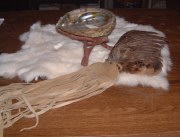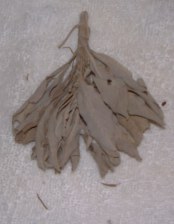


Smudging is the burning of certain herbs such as White Sage, Cedar, and Sweet Grass to create a cleansing smoke like bath , which is used to purify people, ceremonial and ritual space, and ceremonial tools and objects. We use Abalone shells or Clay bowls to burn the herbs in and a fan made if feathers in which we spread the smoke over the body or objects with. Like shown on the left.)
The burning of herbs or incense is a practice held sacred by many Native cultures. It is a ritual for cleansing, purifying and protecting the physical and spiritual bodies. The effect of the smoke is to get rid of negative energies.
Many differing cultures and peoples have their own methods and herbal mixtures for this purpose.
Smudging, done correctly, can bring physical, spiritual and emotional balance.
The term Smudging originated in the Native American culture. Native American Indians use a variety of smudging mixtures. In olden times, the end of the smudge stick or braid was lit from the central or cooking fire.
Not everyone views the practice of smudging in the same way and different herbs may be used for different purposes.
The principle herbs used are sage, cedar or juniper, lavender and sweet grass.
Generally, sage, sweet grass, and cedar are burned to purify and protect one's living area, self and sacred tools.
Pure tobacco is also used by some Plains tribes, in South and Central America.
The herbs are burnt on their own or in mixtures, depending on tradition and required effect.
Sage (Artemisia tridentia) is not the same as the European varieties and is indigenous to the Americas.
There are two major genera and several varieties of each genus of Sage that are used for smudging. Salvia, or the herb sage used for cooking, comes in two major varieties: S. officinalis, commonly known as Garden Sage, and S. apian, commonly known as White Sage. Salvia varieties have long been acknowledged as healing herbs, reflected in the fact that its genus name comes from the Latin root word salvare, which is the verb "to heal" or "to save." Artemisia is the genus commonly considered "Sagebrush", and is more common in California.
There are two major varieties to the Artemisia genus: A. California or Common Sagebrush, and A. vulgaris or Mugwort. There are many other varieties of both Salvia and Artemisia, and all are effective in smudging. Sage is burned in smudging ceremonies to drive out evil spirits, negative thoughts and feelings, and to keep Gan'n (negative entities) away from areas where ceremonials take place. In the Plains Sweat lodge, the floor of the structure is strewn with sage leaves for the participants to rub on their bodies during the sweat.
Sage is also used in keeping sacred objects like pipes or Peyote wands safe from negative influence. In the Sioux nation, the Sacred Pipe is kept in a bundle with sage boughs. I would think special crystals could be so protected this way as well.
Cedar: Cypress and Juniper
True cedar is of the Thuja and Libocedrus genera. Some Junipers (Junipers genus) are also called "cedar", thus complicating things some. Some Juniper varieties are cleansing herbs, especially J. monospermous, or Desert White Cedar. But for smudging, the best is Western Red Cedar (Thuja occidentals) and California Incense Cedar (Libocedrus descurrens). Cedar is burnt while praying to the Great Spirit (Usen', the Source -- also known to Plains nations as Wakan Tanka) in meditation, and also to bless a house before moving in as is the tradition in the Northwest and Western Canada. It works both as a purifier and as a way to attract good energy in your direction. It is usually available in herb stores in chipped form, which must be sprinkled over a charcoal in a brazier. I like a piece of charcoaled mesquite for this purpose, rather than the commercial charcoal cake.
Sweet grass
Very important to the Sioux and Cherokee nations, its botanical name is Hierochloë odorata. In these tribes, the sweet grass is braided like hair braids. It could be burnt by lighting the end of it, or (more economically) by shaving little bits of it onto charcoal in a brazier. Again, use charcoaled Mesquite (I believe it comes packaged for barbecue use under the brand name "Red Arrow") to burn it, not pressed charcoal tablets. Sweet grass is burnt after smudging with sage, to welcome in good influences after the bad had been driven out. Sweet grass is not common today.
Remember that all things are created from some form of electromagnetic energy/ aura and can merge to bring balance or imbalance.
The aura and souls of the plants/herbs and people can merge to this end when smudging.
Smudging is often used by healers. During the healing the smoke may be fanned over the person by the healer either using their hand, feathers or a fan.
This clears out unhealthy energies and brings in the special attributes of the herbs. There are various invocations, chants, and prayers used during the healing.
A spiritual connection is thought to be made between the person and his spirit guides - and between the person and the spirit of the herbs to join and guide in sacred/higher frequency work.
Part of the spiritual work of the plant is to work with human spirits.
When you have the intention to be partners, it enables them to work actively with you and much more of their magic manifests in their lives.